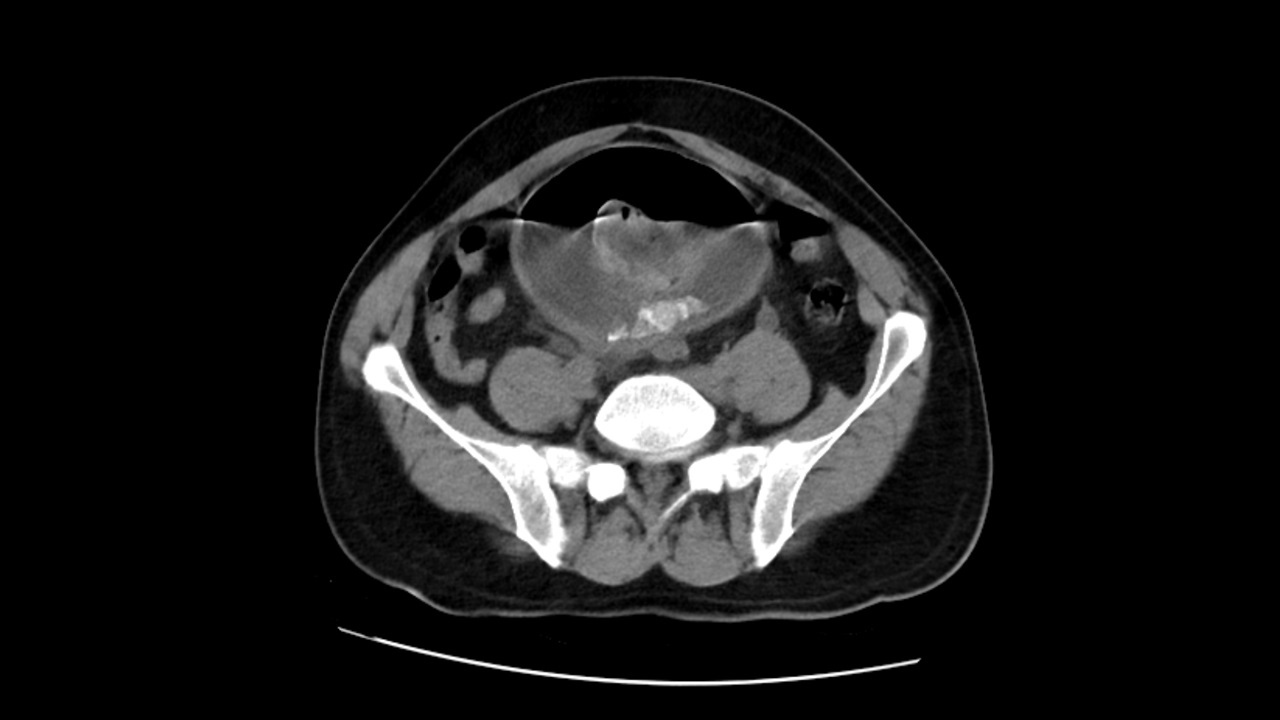Squamous cell carcinoma of the urinary bladder. A case report
DOI:
https://doi.org/10.53903/01212095.163Keywords:
Nephrolithiasis, Carcinoma squamous cell, Urinary bladder, UltrasonographyAbstract
Bladder cancer is the most common cause of malignancy involving the urinary system. Within its clinical spectrum it can manifest as painless hematuria, irritative voiding symptoms (pollakiuria, urgency, dysuria) and urinary obstruction, findings that can delay the diagnosis due to similarity of these symptoms to those of other benign pathologies (UTI, prostatitis, lithiasis, benign prostatic hyperplasia). Squamous-cell carcinoma, of all bladder malignancies, is responsible for the 3-5% of bladder tumors in North America and Europe, the most common being the transitional cell cancer with 95%. (1) We present a case of a 53 years-old man with abdominal pain and irritative voiding symptoms, in whom imaging studies established the diagnosis of bladder tumor. He underwent transurethral cystoscopy and specimens were collected for histopathologic evaluation. The histopathological study with histochemical staining confirmed the finding of a squamous-cell carcinoma of the bladder.
Downloads
References
Martin JW, Carballido EM, Ahmed A, Farhan B, Dutta R, Smith C, et al. Squamous cell carcinoma of the urinary bladder: Systematic review of clinical characteristics and therapeutic approaches [Internet]. Arab J Urol. 2016 [citado: 2020 jul. 27];14:183-91. Disponible en: /pmc/articles/PMC4983161/?report=abstract.
Singh S, Bisht N, Gupta S, Sen A, Joshi R. Squamous cell carcinoma of the urinary bladder associated with large vesical calculus. J Cancer Res Pract [Internet]. 2020 [citado: 2020 dic. 13];7(1):45. Disponible en: https://www.ejcrp.org/article.asp?issn=2311-3006;year=2020;volume=7;issue=1;spage=45;epage=48;aulast=Singh
Instituto Nacional de Cancerología ESE. Análisis de Situación del Cáncer en Colombia. Primera ed. Bogotá DC: Instituto Nacional de Cancerología ESE; 2015.
Jagtap SV, Sarda SD, Demde RB, Huddedar AD, Jagtap SS. Primary squamous cell carcinoma of urinary bladder – A rare histological variant. J Clin Diagnostic Res. [Internet]. 2015 [citado: 2020 jul. 27];9(11):ED03. Disponible en: /pmc/articles/ PMC4668421/?report=abstract.
González Resina R, Sánchez Bernal ML, Pérez Espejo MP, Rodríguez Corchero FJ, Argüelles Salido E, Campoy Martínez P. Carcinoma epidermoide vesical. Revisión de nuestra serie. Archivos Espanoles de Urologia. [Internet]. 2006 [citado: 2020 oct. 14]; 59:785-90. Disponible en: http://scielo.isciii.es/scielo.php?script=sci_arttext&pid=S0004-06142006000800005.
Prendeville S. Pathology outlines. Squamous cell carcinoma [Internet]. PathologyOutlines.com, Inc. 2014 [citado: 2020 oct. 14]. Disponible en: http://www. pathologyoutlines.com/topic/bladdersquamous.html.
Wong JT, Wasserman NF, Padurean AM. Bladder squamous cell carcinoma. RadioGraphics [Internet]. 2004 [citado: 2020 oct. 14];24(3):855-60. Disponible en: http://pubs.rsna.org/doi/10.1148/rg.243035153.
Raman SP, Fishman EK. Bladder malignancies on CT: The underrated role of CT in diagnosis. Am J Roentgenol [Internet]. 2014 [citado: 2020 oct. 14];203(2):347-54. Disponible en: http://www.ajronline.org/doi/10.2214/AJR.13.12021
Magers MJ, López-Beltrán A, Montironi R, Williamson SR, Kaimakliotis HZ, Cheng L. Staging of bladder cancer. Histopathology [Internet]. 2019 [citado: 2020 dic. 8];74(1):112-34. Disponible en: http://doi.wiley.com/10.1111/his.13734.
Wang H, Luo C, Zhang F, Guan J, Li S, Yao H, et al. Multiparametric MRI for bladder cancer: Validation of VI-RADS for the detection of detrusor muscle invasion. Radiology [Internet]. 2019 [citado: 2020 oct. 14];291(3):668-74. Disponible en: http://pubs.rsna.org/doi/10.1148/radiol.2019182506.
Del Giudice F, Barchetti G, De Berardinis E, Pecoraro M, Salvo V, Simone G, et al. Prospective assessment of Vesical Imaging Reporting and Data System (VI-RADS) and its clinical impact on the management of high-risk non–muscle-invasive bladder cancer patients candidate for repeated transurethral resection. Eur Urol. 2020;77(1):101-9.
Panebianco V, Narumi Y, Altun E, Bochner BH, Efstathiou JA, Hafeez S, et al. Multiparametric magnetic resonance imaging for bladder cancer: Development of VI-RADS (Vesical Imaging-Reporting And Data System) [Internet]. European Urology. 2018 [citado: 2020 dic. 8];74:294-306. Disponible en: /pmc/articles/ PMC6690492/?report=abstract.
Verma S, Rajesh A, Prasad SR, Gaitonde K, Lall CG, Mouraviev V, et al. Urinary bladder cancer: Role of MR imaging. Radiographics [Internet]. 2012 [citado: 2020 oct. 14];32(2):371-87. Disponible en: www.rsna.org/rsnarights.

Downloads
Published
How to Cite
Issue
Section
License

This work is licensed under a Creative Commons Attribution-NonCommercial-ShareAlike 4.0 International License.
La Revista Colombiana de Radiología es de acceso abierto y todos sus artículos se encuentran libre y completamente disponibles en línea para todo público sin costo alguno.
Los derechos patrimoniales de autor de los textos y de las imágenes del artículo como han sido transferidos pertenecen a la Asociación Colombiana de Radiología (ACR). Por tanto para su reproducción es necesario solicitar permisos y se debe hacer referencia al artículo de la Revista Colombiana de Radiología en las presentaciones o artículos nuevos donde se incluyan.







